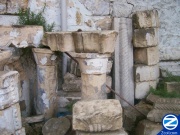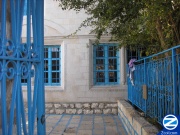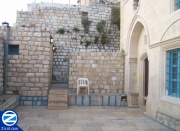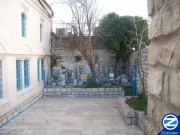Abuhav Synagogue
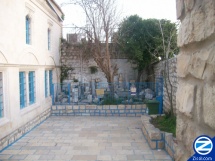 | |
| Hebrew: | |
|---|---|
| בית כנסת אבוהב צפת | |
| Spelling: | |
| Abuhov, Aboab | |
| Other Names: | |
| Abuhav Shul, Abuhav Beit Knesset, The Blue Synagogue | |
| Description: | |
| Old synagogue in Safed, Israel. |
The Abuhav Synagogue is located in Tzfat, Northern Israel. It was originally created during the 16th Century and named after Rabbi Yitzchak Abuhav. Its Ark contains an ancient and very holy Torah scroll personally written by Rabbi Abuhav. During both the 1759 and 1837 earthquakes the Abuhav Synagogue was almost completely destroyed aside from the area surrounding the Torah Ark. Its construction contains a lot of Kabbalistic symbolism. During the Second Lebanon War a katyusha exploded right near the Abuhav Synagogue but it was left undamaged. It is one of the oldest synagogues in Safed and is currently a tourist attraction for the city's visitors. Minyonim using Nusach Edot HaMizrach take place daily in the Abuhav Synagogue as well as Shabbot services.
Contents |
[edit] Origins
Tradition relates that Rabbi Yitzchak Abuhav, a Spanish (some say Portuguese) 15th century rabbi, built the Abuhav synagogue in Spain (or Portugal) and it was magically transported to Tzfat by Rabbi Suliman Ochana during a Kabalistic ceremony. Others say that Rabbi Yitzchak Abuhav planned out the synagogue in his homeland and his students commissioned its construction when they arrived in Tzfat. Rabbi Yitzchak Abuhav handwrote a Torah scroll which is still in use at the shul.
[edit] Destruction and Relocation
The original Abuhav synagogue was built in 15th century Jewish Quarter, above the cemetery. It was destroyed during the 1759 earthquake aside from the area containing the Toarh ark. Survivors moved the Abuhav Torah scroll, which had remained intact, to a safer area and rebuilt the Abuhav synagogue further up the mountain. Others maintain the position that the Abuhav Shul never moved and it was rebuilt in its original location after the earthquake.The Abuhav synagogue was again almost completely destroyed in the 1837 earthquake that leveled the town. The wall holding the Ark and the synagogue’s Torah scrolls, including Rabbi Abuhav’s Torah scroll, remained standing. Several years after the earthquake an Italian philanthropist, Yitzhak Gueta, committed funds to rebuild the Abuhov synagogue. He brought in architects, builders and craftsmen to create a beautiful shul. Care was taken to reconstruct the Abuhav synagogue with similar design and dimensions of the original building.
[edit] Construction and Style
The Abuhav synagogue was constructed in the style of a Sepharadi synagogue and contains much Kabalistic symbolism in its design and structure.
[edit] Torah Scrolls and Arks
There are three Torah Arks in the Abuhav synagogue standing along the southern wall facing Jerusalem. Rabbi Yitzchak Abuhav’s Torah scroll, along with a scroll written by Rabbi Suliman Ochana, is still housed in the same Ark which survived the 1837 earthquake. Congregants only take out the Abuhav scroll on three specific Jewish holidays, Rosh Hashanah, Yom Kippur and Shavouth. Two other Arks sit alongside the right Ark containing the Rabbi Abuhav scroll. In the left Ark, old manuscripts and books are stored while the center Ark holds the Torah scrolls used during the rest of the year. During the era when the Turks ruled Israel, Turkish law stated that any non-Islamic place of prayer must also hold a copy of the Koran. Therefore, during Turkish rule, one Ark held the Koran.Great care is taken never to remove the Abuhav scroll aside from the three allotted times. When the scroll was moved in the wake of the 1759 earthquake, all ten volunteers involved, passed away within that year.
When the Munchaker Rebbe visited the Abuhav Shul in 1930 he requested to see the ancient torah scroll. He carried it to the Bima read from it and then returned the scroll to its Ark.
[edit] The Bima
The “Bima” -- the area where the person leading the prayers stands -- is elevated in the center of the men’s section of the Abuhav synagogue. There are six steps leading up to the bima, representing the six days of the week which lead up to the week’s “crown”, the Sabbath.[edit] Chair of Eliyaho
Facing the main Ark is a chair of Eliyaho that is used for Bris ceremonies. This chair was dedicated in honor of the six million Jews that perished during the Holocaust.
[edit] Courtyard
The Abuhov Shul has a large courtyard that must be crossed to reach the actual synagogue. This courtyard was created to give worshipers the opportunity to properly compose their thoughts before entering the holy sanctuary.[edit] Women’s Section
The women’s section is upstairs and women have a separate door from the back that leads them to their area.
[edit] Ceiling
The ceiling has several connecting domes, ringed with painted designs of birds and other animals. It also contains images of musical instruments used by the Leveim in the Bais Hamikdash and four crowns, representing spiritual statures. The synagogue’s interior contains a large percentage of blue, the Kabbalistic symbol of the heavens. Many people call the Abuhav synagogue “The Blue Synagogue.”
[edit] Location and Services
The Abuhav synagogue is located on Abuhav Street. It has daily “minyans” -- prayer quorums -- including a “Netz” early morning minyan. The congregants at the Abuhav Shul follow Sepharadi Nusach Edot HaMizrach prayer traditions. During the month of “Elul” preceding Rosh Hashanah (the Jewish New Year) and in the days between Rosh Hashana and Yom Kippur, many visitors come to Abuhav throughout the night to experience the moving “Slichot” penitence prayers.
[edit] Lebanon War
The Abuhav Synagogue experienced a modern-day miracle during the 2006 Second Lebanon War. The Abuhav Shul is two doors away from the Alsheich Synagogue. A katyusha rocket landed in-between the two synagogues, alongside the Abuhav’s southern wall. The building where the rocket landed was completely destroyed but neither the Abuhav’s Torah scrolls nor the Alsheich, the oldest standing synagogue in Tzfat, were affected.
| |||||||||||
| |||||||||||||||||
| ||||||||||||||


